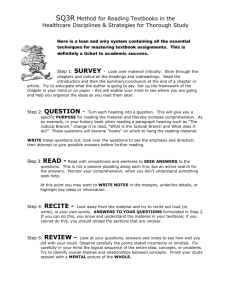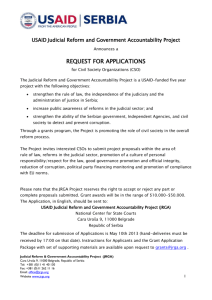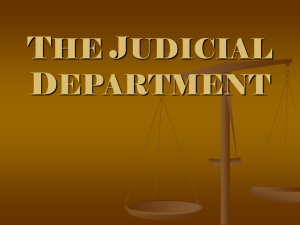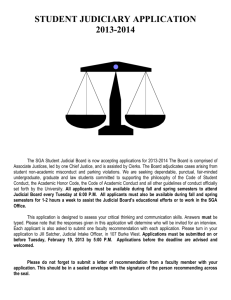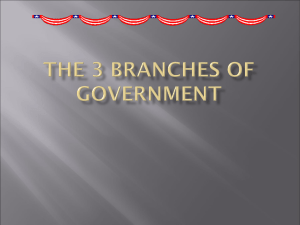Public Law Remedies – Judicial Review
advertisement
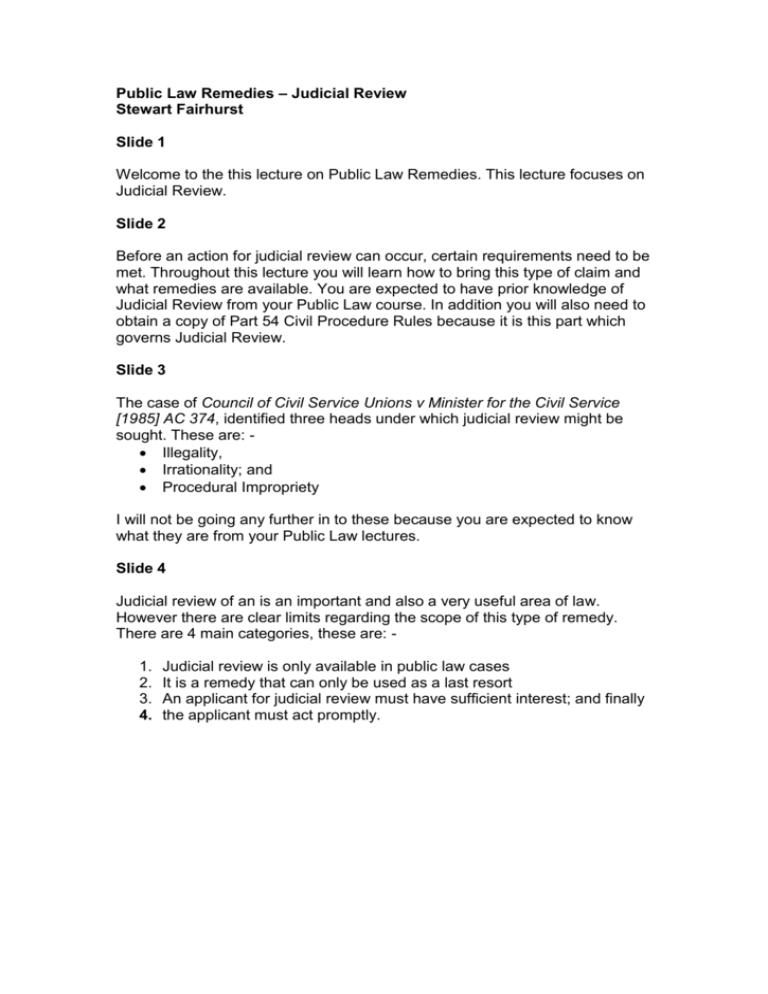
Public Law Remedies – Judicial Review Stewart Fairhurst Slide 1 Welcome to the this lecture on Public Law Remedies. This lecture focuses on Judicial Review. Slide 2 Before an action for judicial review can occur, certain requirements need to be met. Throughout this lecture you will learn how to bring this type of claim and what remedies are available. You are expected to have prior knowledge of Judicial Review from your Public Law course. In addition you will also need to obtain a copy of Part 54 Civil Procedure Rules because it is this part which governs Judicial Review. Slide 3 The case of Council of Civil Service Unions v Minister for the Civil Service [1985] AC 374, identified three heads under which judicial review might be sought. These are: Illegality, Irrationality; and Procedural Impropriety I will not be going any further in to these because you are expected to know what they are from your Public Law lectures. Slide 4 Judicial review of an is an important and also a very useful area of law. However there are clear limits regarding the scope of this type of remedy. There are 4 main categories, these are: 1. 2. 3. 4. Judicial review is only available in public law cases It is a remedy that can only be used as a last resort An applicant for judicial review must have sufficient interest; and finally the applicant must act promptly. Slide 5 A Judicial Review claim is defined by Part 54.1 (2) (a) as a claim to review the lawfulness of (i) an enactment, or (ii) a decision, action or failure to act in relation to the exercise of a public function. So the effect is that when you bring this type of claim, you are challenging the lawfulness of an act of parliament, as in the case of the pro fox hunters or you appealing against a decision, action or omission in relation to a public function. For example you local council may want to build a road through your garden. To overturn this decision you could make a judicial review, especially if they have acted in such a way which amounts to one of the grounds for type of claim. This remedy is available against a decision, action or omission by a public body. This is not just restricted to government agencies or the council. It can also include non-statutory bodies which exercise a public function. For example in the case of R v Panel on Takeovers and Mergers, ex parte Datafin plc [1987] QB 815, it was held that a non-statutory body regulating business dealings in the City of London was susceptible to judicial review. Examples of bodies which can be subject to Judicial Review are, borough councils, government ministers and even the BBC. Not only can a decision of a public body be reviewed but also the decision of an inferior court can be challenged. For example decisions of the Magistrates court can be challenged using this method. However it must be noted that Section 29 subsection 3 of the Supreme Court Act 1981 excludes Judicial Review of the decisions of the Crown court if the decision does not relate to a matter on indictment. So what happens if you have a case where you feel that an appeal will be successful. For example you intend to appeal against a decision made by the Magistrates court regarding a point of law they have, in your opinion, interpreted incorrectly. What do you do? Well in this situation you make an appeal to the Crown Court or you can make a judicial review. Problems can arise as to which process of appeal you should use. Fortunately there is guidance on this matter. We are looking at this next. Slide 6 The answer to this question lies with a judgement made by the Court of Appeal in the Trustees of Dennis Rye Pension Fund and Sheffield City Council which can be found at volume 4 of the 1997 All England Law Reports at page 747. The Court stated the following: 1. If it is not clear which method to use, whether judicial review or a private law remedy, it is safer to use judicial review. 2. If a case is brought seeking a private law remedy and an action is raised to strike out the claim, the court, before it does must ask itself whether it is clear that permission would have been granted had the clamant sought to bring judicial review proceedings. 3. If the claimant brings a private law claim which is more appropriate than an application for judicial review, any application to strike the claim out on grounds that it should be tried by judicial review will not succeed. 4. If the claimant brings a private claim, and it is unclear whether proceedings should have been brought by way of judicial review, the court should consider its ability to transfer the case to the Crown Office list instead of striking out the claim. 5. The choice made by the claimant as to which way to proceed with their case, will not be considered an abuse of process where that choice has no significant advantage for either party, the public or the court. Slide 7 Basic guidance can be drawn from Section 31 (3) Supreme Court Act 1981. This states that an applicant MUST have sufficient interest in a matter to which the application relates. Sufficient interest is not defined either by the Act above or the Civil Procedure Rules, but its meaning was considered in the case of R v IRC ex parte National Federation of Self Employed and Small Businesses [1982] AC 617 by Lord Denning MR who said: “The men are called the Fleet Street casuals. There are about 6,000 of them. They do casual work for newspapers. They love a bit of humour. When signing their day dockets, they do not sign their true names. Hey use fictitious names and addresses. One favourite is Mickey Mouse of Sunset Boulevard. But they do not sign in these names merely for fun. They use them for a serious purpose. It is to hide their true identities so that they should not be discovered by the taxmen. By this means the Fleet Street casuals have defrauded the Revenue of about £1 million a year. The employers did not know their true names. Only the unions did and the revenue had no access to these lists. So they could not assess them for tax. This dodge was publicised by panorama. The Inland Revenue came under great pressure to put a stop to the practice. The unions threatened strike action if changes were made. The Government was anxious to avoid a newspaper strike. The Inland revenue reached a deal that they would not try to recover back taxes provided the practice ceased forthwith.” The National Federation challenged the legality of the Inland Revenue’s actions. But did they have standing? Their legal rights were not affected. The Court of Appeals decision that they had standing was reversed by the House of Lords who felt that they did not have sufficient interest. The court in this case also stated that pressure groups did not have sufficient standing. In order to be heard, applicants must have the requisite standing (locus standi). The majority of judges in the IRC case agreed that the court was forced to consider questions of standing at: - The permission stage; and - At the main stage (second stage) They tended to link the requirements of standing to the merits of the application. The stronger the case, the greater the illegality claimed and the more generous the courts would be in allowing people to challenge a decision. In the IRC case the judges were divided as to whether there was the same test of standing for each of the remedies because traditionally the courts had been more generous in allowing certain orders than for other remedies. The judges were agreed that:- You did not need to have a legal interest in order to challenge; and - Busybodies should not be allowed to challenge. We were given some guidance by the Lord Diplock In R v IRC ex parte National Federation of Self Employed and Small Businesses [1982] AC 617 at page 643. He said: “The purpose is to prevent the time of the court being wasted by busybodies with misguided or trivial complaints of administrative error, and to remove the uncertainty in which public officers and authorities might be left as to whether they could safely proceed with administrative action while proceedings for judicial review of it were actually pending though misconceived” Whether a person has an interest depended upon the strength of their application. Subsequent cases were very generous in allowing people to challenge illegality. The case of R v Felixstowe JJ ex parte Leigh and another [1987] 2 QB 582 demonstrates how the court dealt with a problem concerning the standing of one of the applicants. “The question whether a person had sufficient interest to bring an application for judicial review had to be decided by the court in its discretion on the facts of the particular application. In the circumstances the applicant had failed to show that he had a sufficient interest in the disclosure of the justices’ names for the purpose of his article. It followed that he was not entitled on that ground to an order for mandamus. However, he had sufficient interest because of the public interest in the maintenance and preservation of open justice in magistrates’ courts, which was a matter of vital concern in the administration of justice, to seek a declaration. The declaration would accordingly be granted.” There has been some deviation from the guidelines laid down in the IRC case, in that pressure groups have been heard by the court. The courts are willing to hear pressure groups particularly if they have a record of involvement. Each case is subjective and decided independently of each other. Slide 8 There is a need for the applicant to act promptly. Section 31 (6) of the Supreme Court Act 1981 provides: Where the High Court considers that there has been undue delay in making an application for judicial review, the court may refuse to grant leave for the making of the application; or any relief sought on the application, if it considers that the granting of the relief sought would be likely to cause substantial hardship to, or substantially prejudice the rights of, any person or would be detrimental to good administration. CPR rule 54.5(1) states that the claim form seeking judicial review must be filed “promptly and in any event not later than three months after the grounds to make the claim first arose”. Therefore a claim may fail on grounds for delay even if it is brought within the three month period. If the three month period has already expired, the court may grant an extension of time, but only if there is “good reason” for doing so. For further information on this see rule 3.1 (2) (a) of the Civil Procedure Rules. Slide 9 The procedure for seeking judicial review is contained in CPR Part 54 and PD 54. An application for judicial review has two stages:Permission to seek judicial review; and then if granted The Substantive application for review, which is also known as the Hearing. At the permission stage the applicant must ask for permission to apply for judicial review. The court generally at first instance will hear this without a hearing. The main purpose of this stage is to weed out the hopeless cases. Where there is a hearing at the stage, the defendant or any other interested party need turn up unless the court directs otherwise. Where the defendant or other interested party does turn up, the court will not generally makes any costs award against an unsuccessful claimant. If the applicant has sufficient standing to bring the claim for judicial review and there has not been any undue delay, the judge will go on to consider the merits of the application. The test applied by the judge is whether the claimants application discloses an arguable case. Should the applicant be successful at the permission stage, the claim can then move to he next stage. That is the main substantive application. Criminal cases are heard by the Divisional Court, normally with two High Court judges and civil cases are heard by the Divisional Court, normally with one High Court judge. The hearing involves legal argument based on the contents of the claim form and written evidence. Since evidence is mainly written, it is rare to have a judicial review involving the cross examination of witnesses. The calling of witnesses will only occur if there is a genuine question of fact which needs to be resolved and cannot be resolved on the face of the written evidence. Slide 10 The remedies which may be granted following an application for judicial review are set out in CPR rule 54.2. The principal public law remedies which may be granted are: A quashing order which has the effect of quashing the decision being challenged. A mandatory order which has the effect of requiring the defendant to carry out a particular public duty; most commonly, the effect is to compel a decision maker to reconsider his decision; and finally, A prohibiting order (which has the effect similar to that of an injunction, in that it prevents a public body from acting or continuing to act in a way which is unlawful. Please note that rule 54.19 of the Civil Procedure Rules, provides that where the court makes a quashing order, it may remit the matter to the decision maker and direct the decision maker to reconsider the matter and reach a decision in accordance with the judgement of the court. However where the court considers that there is no purpose to be served in remitting the matter to the decision maker, the court may take the decision itself. Slide 11 In addition to the remedies available under Rule 54.2, Rule 54.3 extends the powers of the court when considering a remedy for a judicial review claim. These are a declaration, the effect of which is to state the law on a particular point. For example if a decision is quashed because the decision maker misunderstood the law, the court can grant a declaration setting out the correct interpretation. The second power the court has under this rule is to be able to grant an injunction. Slide 12 A claim for judicial review may include a claim for damages but cannot be used to claim damages alone. See rule 54.3(2) of the Civil Procedure Rules. More than one remedy may be sought in the same application. The grant of a remedy is discretionary. Reasons for refusing to grant a remedy sought include matter such as: - The conduct of the applicant, so that the applicant does not deserve assistance. - Adverse consequences to the public as a whole. - If no harm would have been done and had the decision maker followed the correct procedures it would have not made any difference. Slide 13 That concludes this lecture. Thank you for listening.



